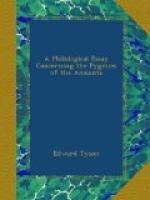[Footnote A: Laing, Prehistoric Remains of Caithness, p. 101.]
[Footnote B: Journ. Anthrop. Inst., xiii. 60.]
(2.) The mounds with which the tales of little people are associated have not, in many cases, been habitations, but were natural or sepulchral in their nature. It may, of course, be argued that the story having once arisen in connection with one kind of mound, may, by a process easy to understand, have been transferred to other hillocks similar in appearance, though diverse in nature. It is difficult to see, however, how this could have occurred in Yorkshire and other parts of England, where it is not argued that the stunted inhabitants of the North ever penetrated. It is still more difficult to explain how similar legends can have originated in America in connection with mounds, since there never were Pigmy races in that continent.
(3.) The rude and simple arrangements of the interior of these mound dwellings might have, in the process of time, become altered into the gorgeous halls, decked with gold and silver and precious stones, as we find them in the stories; they might even, though this is much more difficult to understand, have become possessed of the capacity for being raised upon red pillars. But there is one pitch to which, I think, they could never have attained, and that is the importance which they assume when they become the external covering of a large and extensive tract of underground country. Here we are brought face to face with a totally different explanation, to which I shall recur in due course.
(4.) The little people are not by any means associated entirely with mounds, as the foregoing section is largely intended to show. Their habitations may be in or amongst stones, in caves, under the water, in trees, or amongst the glades of a forest; they may dwell on mountains, on moors, or even under the altars of churches. We may freely grant that some of these habitations fall into line with Mr. MacRitchie’s theory, but they are not all susceptible of such an explanation.




